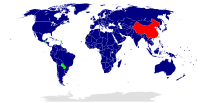
Photo from wikipedia
The study investigates the linguistic aspects of Chinese and American diplomatic discourse using Biber’s theoretical underpinnings of multi-dimensional (MD) analysis. The corpus of the study comprises texts taken from the… Click to show full abstract
The study investigates the linguistic aspects of Chinese and American diplomatic discourse using Biber’s theoretical underpinnings of multi-dimensional (MD) analysis. The corpus of the study comprises texts taken from the official websites of the Chinese and US governments from 2011 to 2020. The study results show that China’s diplomatic discourse falls into the text type of learned exposition which includes informational expositions focused on conveying information. In contrast, the United States diplomatic discourse falls into the text type of “involved persuasion,” which is persuasive and argumentative. Furthermore, the two-way ANOVA test reveals few distinctions between spoken and written diplomatic discourse from the same country. Furthermore, T-tests demonstrate that the diplomatic discourse of the two countries differs significantly in three dimensions. In addition, the study highlights that China’s diplomatic discourse is informationally dense and context independent. In contrast, the United States diplomatic discourse is emotive and interactional, strongly dependent on context, and created within time restrictions. Finally, the study’s findings contribute to a systematic knowledge of the genre aspects of diplomatic discourse and are helpful for more effective diplomatic discourse system creation.
Journal Title: Frontiers in Psychology
Year Published: 2023
Link to full text (if available)
Share on Social Media: Sign Up to like & get
recommendations!